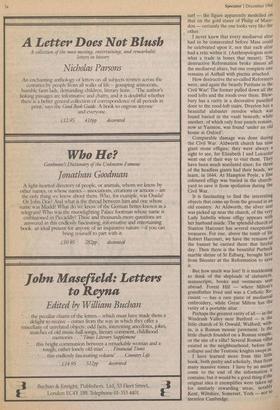Oxon treasures
A. L. Rowse
Church Treasures in the Oxford District E. B. Ford and J. S. Haywood (Alan Sutton, Gloucester £4.95) Here is a most remarkble booklet, far more worthwhile than most Christ- mas presents. It is based on an original idea: to spotlight the rarest, sometimes unique, treasures, artistic or archaeologic- al, within 20 miles of Oxford.
Some people may be aware of some of these rarities. Many may know the beauti- ful Jesse window in the fine abbey church at Dorchester (Oxfordshire), but not that it is the only remaining one in the country. Again, it has an extreme rarity in an 'action statue', ie an effigy of a mediaeval knight drawing his sword — a theme apparently unknown in Europe. The lead font with its figures of the Apostles is famous; but we learn that, of the 30 metal fonts in the whole country, five are in this circuit. The church also has some of the earliest glass, late 12th-century; this would have been imported from the Continent.
For the art of glass-making was lost in the frightful decline of civilisation that came about with the end of Roman Bri- tain. Under the Romans, even the barracks of the common soldiers on Hadrian's Wall were glazed, though we learn that Roman glass was translucent, not transparent.
How many things one learns from this little book! Did you know that the Anglo- Saxons divided the day not into hours but into eight tides — hence noon-tide and even-tide? Thus Anglo-Saxon sundials we are given a photograph of one at Langford — are recognisable to the perceptive eye. That church has also two Anglo-Saxon roods; one of these had been moved and put together again ignorantly, with the limbs and figures misplaced; Mr Haywood has ingeniously rearranged the sections to show us more nearly how it ought to be.
England differed from the Continent in equipping its churches with a whole set of consecration crosses on the exterior. Uffington still has a set practically com- plete. Every year, the consecration was commemorated by lighting a candle before each cross; sometimes one finds a bracket for it still. Above that church is the earliest White Horse in the country cut into the turf — the figure apparently modelled on that on the gold stater of Philip of Mace- don — certainly the one looks very like the other.
I never knew that every mediaeval altar had to be consecrated before Mass could be celebrated upon it, nor that each altar had a relic within it. (Anthropologists note what a trade in bones that meant). The destructive Reformation broke almost all the mediaeval altars, but one complete one remains at Asthall with piscina attached.
How destructive the so-called Reformers were, and again the beastly Puritans in the Civil War! The former pulled down all the rood lofts and the roods over them. Blew- bury has a rarity in a decorative panelled door to the rood-loft stairs. Drayton has a beautiful alabaster reredos which was found buried in the vault beneath; while another, of which only four panels remain, now at Yarnton, was found 'under an old house at Oxford'.
Comparable damage was done during the Civil War. Aldworth church has nine giant stone effigies; they were always a sight to see, for Elizabeth I and Leicester went out of their way to visit them. They have been much mutilated since; for three of the headless giants had their heads, we learn, in 1644. At Hampton Poyle, a fine coloured effigy was buried in the church- yard to save it from spoliation during the Civil War.
It is fascinating to find the interesting objects that come up from the ground in an old country. At Aldworth, the silver seal was picked up near the church, of the very Lady Isabella whose effigy appears with her husband inside. The splendid church of Stanton Harcourt has several exceptional treasures. For one, above the tomb of sir Robert Harcourt, we have the remains of the banner he carried there that fateful day. Then there is the beautiful Purbeck marble shrine of St Edburg, brought here from Bicester at the Reformation to save it.
But how much was lost! It is maddening to think of the shiploads of alabasters, manuscripts, books and vestments sent abroad. Forest Hill — where Milton's grandfather lived and was a Catholic Re- cusant — has a rare piece of mediaeval embroidery, while Great Milton has the rarity of a portable altar. Perhaps the greatest rarity of all — in the Windrush Valley near Burford — is the little church of St Oswald, Widford; with- in, is a Roman mosaic pavement. Is the little church founded on a Roman temple, or the site of a villa? Several Roman villas existed in the neighbourhood, before the collapse and the Teutonic knights swept in.
I have learned more from this little book, both pretty and scholarly, than from many massive tomes. I have by no means come to the end of the information it contains; but it would be a good thing ifthe
original idea it exemplifies were taken uP for similarly rewarding areas, notably Kent, Wiltshire, Somerset, York — not to mention Cambridge.























































 Previous page
Previous page